Beef carcass grading is an important step in delivering consistent beef products to consumers. Grading places carcasses into uniform groups of similar quality. The information collected through the grading process is used in making marketing and production decisions. Producers receive premiums for carcasses with a high grade. While the grading system is voluntary, virtually all fed beef carcasses processed commercially in Canada are graded.
| Key Points |
|---|
| The quality grade measures numerous characteristics that reflect the eating quality of the beef |
| Carcasses from youthful cattle may receive a quality grade of Canada Prime, A, AA, AAA or B1-B4 |
| Carcasses from mature cattle may receive a grade of D1-D4 or E. |
| In youthful cattle, yield grades 1, 2, 3, 4 or 5 estimate the percentage of the carcass that is saleable at retail |
| As of January 15, 2019, Canadian and U.S. Retail Yield grades 1 to 5 are both based on external fat depth, ribeye area, hot carcass weight and an estimate of kidney, pelvic and heart fat (KPH) |
What is a Beef Carcass?
As indicated in Canada’s Beef, Bison and Veal Carcass Grade Requirements, a beef carcass is the carcass of a slaughtered bovine animal that is produced for beef and has had the following removed, namely,
(a) the hide,
(b) the portion of the head and neck forward of the first cervical vertebra,
(c) the portion of the foreshank below the carpal (knee) joint and the portion of the hindshank below the tarsal (hock) joint,
(d) the respiratory, digestive, reproductive and urinary systems and the thoracic and abdominal organs,
(e) the membranous portion of the diaphragm and the pillar of the diaphragm,
(f) the spinal cord,
(g) the kidney fat, pelvic fat, heart fat and scrotal or udder fat,
(h) the tail posterior to the first coccygeal vertebra and
(i) any portion of the carcass the removal of which is required for pathological reasons under the Safe Food for Canadians Regulations.
How Canadian Beef is Graded
The Canadian beef grading system follows standards overseen by the Government of Canada based on industry and government recommendations. The Canadian Beef Grading Agency (CBGA), a private, non-profit corporation, is accredited by the Canadian Food Inspection Agency to deliver grading services for beef in Canada. Trained graders visually assess the whole carcass based on several criteria and assign a grade.
All carcasses graded Canada A or higher receive both a quality grade and a yield grade.
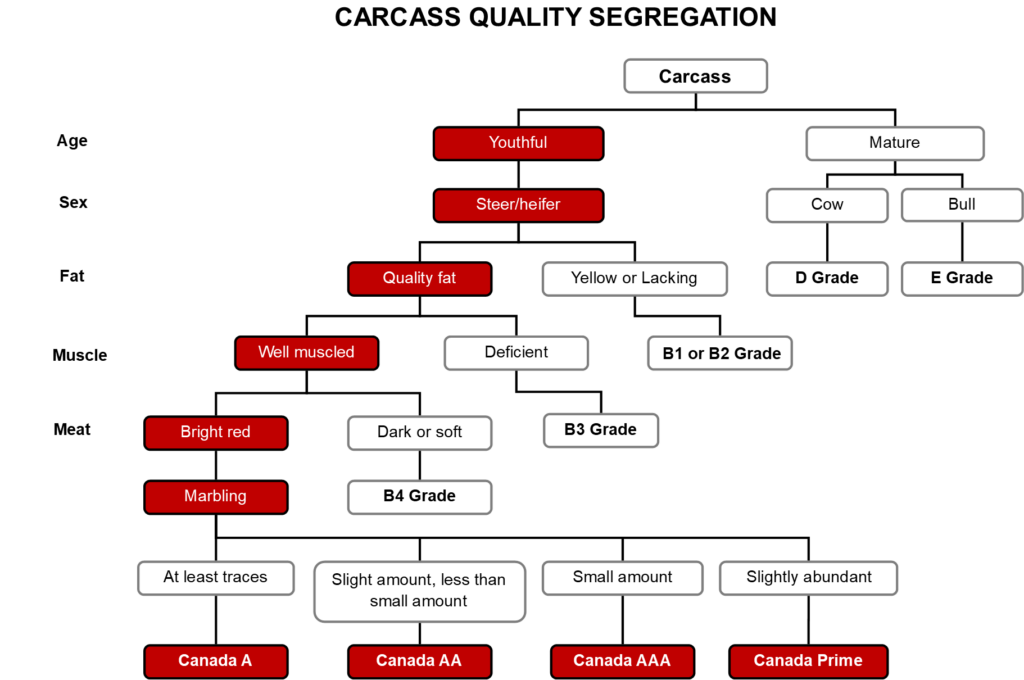
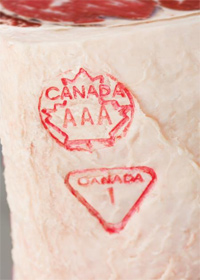
Quality Grade
The quality grade measures numerous characteristics, which reflect meat quality. A beef carcass may only be graded after it has been inspected and approved for health and safety standards and bears a federal or provincial meat inspection legend or stamp.
| CHARACTERISTIC | INFLUENCE ON QUALITY |
|---|---|
| Maturity | The age of an animal affects the tenderness. Carcasses are categorized as youthful or mature. |
| Sex | Pronounced masculinity in animals affects meat colour and palatability. |
| Conformation (muscling) | Meat yield is influenced by the degree of muscling. |
| Fat (colour, texture and cover) | Fat colour and texture influence consumer acceptability. Fat cover affects retail yield. |
| Meat (colour, texture and marbling) | Marbling affects eating quality for juiciness and tenderness. Colour and texture influence consumer acceptability. |
Canada Prime: The highest marbled quality beef carcasses are given the Canada Prime grade. Canada Prime represents carcasses with at least “slightly abundant” marbling. In 2023, the Canada Prime grade represented 4.8% of all graded beef from fed slaughter cattle in Canada.
A Grades: Canada A grades (A, AA, AAA) are also high-quality grades, representing increasing degrees of marbling from Canada A to AAA respectively. The segregation into different marbling ranges permits consumers, retail and food service options in fat content. In 2023, the Canada A, AA, AAA and Prime grades together represented 95.4% of all graded beef from youthful slaughter cattle in Canada.
B Grades: The B grades are for youthful carcasses that fail to meet one or more of the quality requirements of the A grades. In 2023, B grades represented 1.56% of all graded beef from youthful slaughter cattle in Canada. Some beef from B-grade carcasses may be used in fast food service.
Carcasses graded as B4 are called dark cutters. They are visually unappealing and have a higher pH than typical beef. Beef from dark cutters is often used in further processed products.
D Grades: The D grades are applied to carcasses which are not youthful. They are typically given to carcasses from cows and represented 12.6% of the total graded cattle in Canada in 2023. Beef given a D grade is typically used for ground beef and further processed products. However, with the D1 grade, whole muscle cuts may be used in low-cost food service enterprises.
E Grades: The E grade is reserved for mature bulls or youthful bull carcasses showing pronounced masculinity. This grade represented 0.5% of the total graded cattle population in Canada in 2023. These carcasses typically go into further processed products.
Because grading is voluntary, cows and bulls are often not graded and are labeled as “ungraded” beef when sold.
| Canadian Grade | Maturity (Age) | Muscling | Rib Eye Muscle | Marbling | Fat Colour and Texture | Fat Measure |
|---|---|---|---|---|---|---|
| CANADA PRIME | Youthful | Good to excellent with some deficiencies | Firm, bright red | Slightly abundant | Firm, white or amber | 2 mm or more |
| CANADA A, AA, AAA | Youthful | Good to excellent with some deficiencies | Firm, bright red | A – trace AA – slight AAA-small |
Firm, white or amber | 2 mm or more |
| B1 | Youthful | Good to excellent with some deficiencies | Firm, bright red | No requirement | Firm, white or amber | Less than 2 mm |
| B2 | Youthful | Deficient to excellent | Bright red | No requirement | Yellow | No requirement |
| B3 | Youthful | Deficient to good | Bright red | No requirement | White or amber | No requirement |
| B4 | Youthful | Deficient to excellent | Dark red | No requirement | No requirement | No requirement |
| D1 | Mature | Excellent | No Requirement | No Requirement | Firm, white or amber | Less than 15 mm |
| D2 | Mature | Medium to excellent | No requirement | No requirement | White to yellow | Less than 15 mm |
| D3 | Mature | Deficient | No requirement | No requirement | No requirement | Less than 15 mm |
| D4 | Mature | Deficient to excellent | No requirement | No requirement | No requirement | 15 mm or more |
| E | Youthful or Mature | Pronounced masculinity (enlarged: hump, neck, crest, pizzle eye) | Pronounced masculinity (enlarged: hump, neck, crest, pizzle eye) | Pronounced masculinity (enlarged: hump, neck, crest, pizzle eye) | Pronounced masculinity (enlarged: hump, neck, crest, pizzle eye) | Pronounced masculinity (enlarged: hump, neck, crest, pizzle eye) |
Yield Grade
When a carcass qualifies for Canada Prime or any of the Canada A grades, a prediction of carcass retail yield is also made.
Yield grades 1, 2, 3, 4 or 5 is an estimation of the percentage of the carcass that is saleable at retail.
| Yield Grade | Estimated Yield (%) |
|---|---|
| Canada 1 | 52.3 or more |
| Canada 2 | 52.34 to 50.0 |
| Canada 3 | 47.7 or 50.0 |
| Canada 4 | 45.4 to 47.7 |
| Canada 5 | Less than 45.4 |
A ruler developed by the Agriculture and Agri-Food Canada Lacombe Research Station, is used to measure the fat depth and ribeye length and width. These measures of fat and lean are then used to predict an overall carcass lean yield.

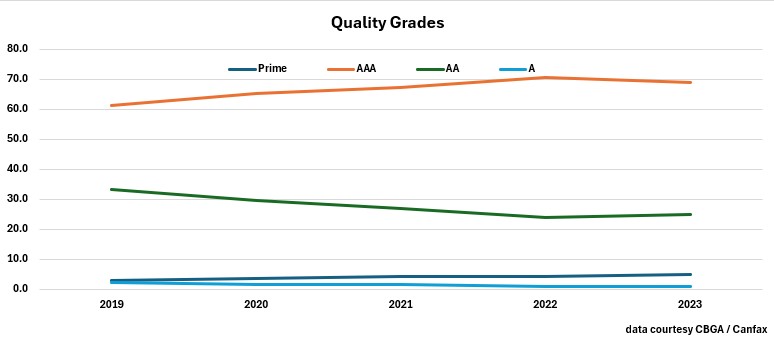
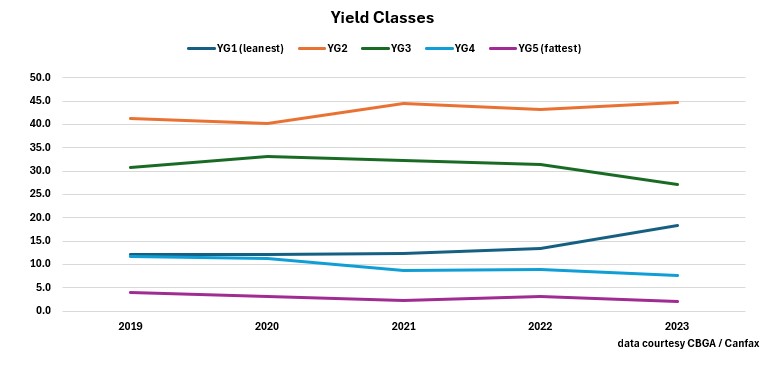
U.S. Grade Equivalency
The U.S. equivalent grade for Canada Prime is USDA Prime. Canada AAA, AA and A are equivalent to USDA Choice, Select and Standard respectively.
As of January 15, 2019, Canadian and U.S. Retail Yield grades 1 to 5 are both based on external fat depth, ribeye area, hot carcass weight and an estimate of kidney, pelvic and heart fat (KPH). These yield grades predict the percentage of closely trimmed, boneless retail cuts from the round, loin, rib and chuck.
Beef Grading Advancements
Evaluating and developing grading tools and sharing information are necessary to improve the grading process for the delivery of a consistent beef product and for sending signals back to producers for livestock production.
e+v Technology
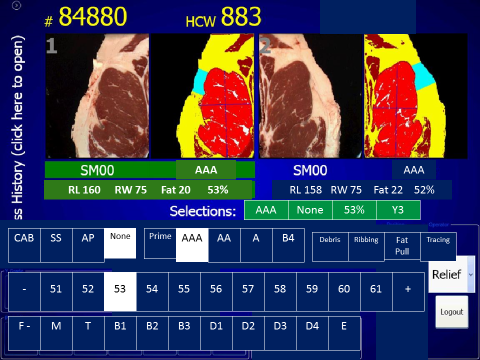
One of the most recent developments is the computer vision grading system e+v Technology GmbH Beef Instrument Technology. It marks the first major advancement in the Canadian system since the Computer Vision System (CVS) camera was introduced in 1999. The e+v technology is approved for use as a grading aid by the Canadian Food Inspection Agency and enables improved grading accuracy under current grading regulations.
The e+v grading instrument is a stationary machine that photographs and analyzes the rib eye area between the 12th and 13th ribs of both sides of each carcass as it passes by on a moving rail. At present, the computer grading camera measures grade fat, rib eye width and rib eye length and then calculates a lean-yield percentage, providing a lean-yield grade and a marbling score. In some situations, such as where it is difficult for the camera to get an accurate reading, a grader can provide an overall assessment or override the camera’s grading.
The technology is objective and assesses marbling under the same light and at the same distance from the rib eye based on minute calculations of red and white pixels within the traced muscle. This reduces the variability inherent with human assessment. The information captured can be stored, shared and further analyzed.
Tenderness Testing
Measuring tenderness is time consuming and costly. Traditional methods of evaluating tenderness involve destructive processes such as slicing, shearing or chewing. Genetic tests have limited practical use.
Researchers have studied whether rapid evaporative ion mass spectrometry (REIMS) technology can accurately assess tenderness. Though the cleaning process is intensive, this technology has the potential for use in laboratory settings as a quick, easy to use option.
Information Sharing
A number of private industry initiatives are taking advantage of the developments in individual animal identification, instrument grading and information sharing systems to share individual carcass data back down the supply chain to previous owners of the animal. This information can help packing plants to procure cattle that will meet customer demands, help cattle feeders refine their nutritional and implant management strategies, help cow-calf producers bolster their bull selection and calf marketing efforts and help seedstock breeders with their selection programs. Over time, this is likely to contribute to enhancing the quality and yield of Canadian beef.
Current Research
Further research is currently underway to:
- understand how animal production practices and postmortem processing factors affect beef grade and quality attributes
- provide strategies to producers and processors for improving beef carcass grade and meat quality
- increase understanding of how muscle biochemistry and structure relate to beef carcass grade and ultimate meat quality
- produce an affordable, objective and portable beef grading machine prototype
Feedback
Feedback and questions on the content of this page are welcome. Please e-mail us at [email protected].
Acknowledgments
Thanks to Cindy Delaloye, retired General Manager of the Canadian Beef Grading Agency, for contributing her time and expertise to developing this page.
This content was last reviewed November 2024.